1-(4-Isoxazolyl)-7-hydroxy-3-heptanones
US-44541774-A
Stocking
Nationwide
(en)1-(4-Isoxazolyl)-7-hydroxy-3-heptanone compounds of the type WHEREIN R1, R2 and R4 are hydrogen or lower alkyl and R3 is hydrogen, lower alkyl, lower alkylphenyl or phenyl lower alkyl. The compounds are useful as steroidal intermediates.
1.ApplicationNumber: US-44541774-A
1.PublishNumber: US-3873562-A
2.Date Publish: 19750325
3.Inventor: SAUCY; GABRIEL
4.Inventor Harmonized: SAUCY GABRIEL()
5.Country: US
6.Claims:
(en)1-(4-Isoxazolyl)-7-hydroxy-3-heptanone compounds of the type WHEREIN R1, R2 and R4 are hydrogen or lower alkyl and R3 is hydrogen, lower alkyl, lower alkylphenyl or phenyl lower alkyl. The compounds are useful as steroidal intermediates.
7.Description:
(en)United States Patent [1 1 Saucy [111 3,873,562 Mar. 25, 1975 1-(4-ISOXAZOLYL)-7-HYDROXY-3- HEPTANONES [75] Inventor: Gabriel Saucy, Essex Fells, NJ.
[73] Assignee: Hoffman-La Roche Inc., Nutley,
22 Filed: Feb. 25, 1974 2| Appl. No.: 445,417
Related U.S. Application Data [62] Division of Ser. No. 259,724, June 5, 1972, Pat. No. 3,813,41 l, which is a division of Ser. No. 81 1, Jan. 5, I970, Pat. No 3,69l,l89.
[52] U.S. Cl. 260/307 H [51] Int. Cl C 07d 85/22 [58] Field of Search 260/307 H [56] References Cited UNITED STATES PATENTS 3,700,661 lO/l972 Saucy et al 260/240 E Primary Examiner-Donald G. Daus Assistant E.\aminerRaymond V. Rush Attorney, Agent, or Firm-Samuel L. Welt; Jon S. Saxe; George M. Gould wherein R R2 and R are hydrogen or lower alkyl and R is hydrogen, lower alkyl, lower alkylphenyl or phenyl lower alkyl. The compounds are useful as steroidal intermediates.
2 Claims, N0 Drawings 1 l-(4-ISOXAZOLYL)-7-HYDROXY-3-HEPTANONES CROSS REFERENCE TO RELATED APPLICATIONS This application is a divisional of U.S. Pat. application Ser. No. 259,724 filed June 5, 1972, now U.S. Pat. No. 3,813,411, which is a divisional of U.S. Pat. application Ser. No. 811, filed Jan. 5, 1970, now U.S. Pat. No. 3,691,189, issued Sept. 21, 1972.
BRIEF DESCRIPTIQND THE. NVENTIQN The present invention relates to novel processes useful in the preparation of isoxazolyl substituted lactones of the following formula wherein R R and R are selected from the group consisting of hydrogen and lower alkyl and R is selected from the group consisting of hydrogen,
lower alkyl, lower alkylaryl and aralkyl.
As used herein the term lower alkyl is meant to include both branched and straight chain hydrocarbon radicals having from 1 to 7, preferably 1 to 4, carbon atoms. Examples of suitable lower alkyl groups include methyl, ethyl, propyl and butyl. Examples of suitable lower alkylaryl groups include tolyl, xylyl, and the like. The term aralkyl is meant to include groups such as phenyl lower'alkyl, e.g., benzyl and phenylethyl.
The processes of the present invention utilized to prepare compounds of formula I above are more readily understood by reference to the following reaction scheme:
i l I12 x v11 R2 N1 l 1[OCH(CH3)ala an where where R and R are as above. 1, 2, a and 4 are as above, 20 This reaction is conveniently conducted at a temper- 5 taken independently is y g or lower y ature in the range of from about to 150C, most s taken in ependently is lower alkyl or aralkyl and preferably at the reflux temperature of a suitably high and s taken together with the adjacent hitfO- boiling inorganic solvent. Suitable inert organic solgen atom form a 5 0r 6 membefed Saturated hetervents for this purpose include aromatic hydrocarbons,
ocychc ring including at the most one adfhtiohal most preferably xylene or toluene. The reaction prodhetero atom e ected o the g p eonslsnng 0f uct obtained is a compound of formula III which as innitrogen and oxygen. dicated in the above reaction scheme is believed to The reaction sequence outlined in the above react1on exist as a Complex ilib i i t r t i i th scheme utilizes either amino ketones of the structure two Structures Shown I f d d l r a ti shown in formula ll A or vinyl ketOneS of formula II B resonance spectra indicate that the predominate form as alternative starting materials. It is to be noted that in thi equilibri is the form indicated by subformula when the amino ketones'of formula II A are placed in II A. However, it is understood that this equilibrium Solution some of this compound is Converted to the can be shifted by changes in the ambient conditions vinyl ketone of formula II B. Either type of compound h a t t lv t sy t a d the H of th or mixtures thereof can be used s Starting material solution. The exact structure of compounds of formula The amino moiety repr n y R5R6N in formula III is not believed to be critical to the practice of the ll A can be a lower alkyl amine Suc m hyl min present invention. It is also possible to use compounds et yla p py a n-butylamine, hexylamine, of formula III in crude form for such further transforetc., preferably n-butylamine; aralkylamines such as ti a'methylbehlylamthe and amines of Complex m 4O Compounds of formula III are then treated with hyul s su h as, f r xampl hydr a i tylamin uitdroxylamine or a salt thereof in step (b) to yield mixed able amino groups also include di-lower alkylamines isomers of the bis-oxime of formula IV. This reaction which may optionally contain additional substituents i conveniently co duct d at a temperature in the n h y g p, -g phenyl or cyclic amino groups. range of from about 0 to 100C, most preferably at Examples of such di-substituted amines include diabout room temperature. Suitable salts of hydroxylmethylamine, diethylamine, methylethylamine and the amine include the mineral acid salts of hydroxylamine, like. Diethylamine is preferred. The amino moiety may most preferably the hydrochloride salt. The reaction is also comprise a cyclic group optionally containing an most desirably conducted in the presence of an organic additional hetero atom in the ring. Examples of cyclic b t f bl a tertiary amine h as a iamines include pyrrolidine and piperidine. Morpholine lower alkylamine, e g triethylamine o pyridine,
is an example of a cyclic amine having an additional In step (c) the bis-oxime of formula IV is converted hetero atom. by heating to the isoxazole oxime of formula V. Suit- The preparation of starting materials Of formula II A able solvents for use in this transformation step include iS described in some detail in [1.8. Pat. application Ser. rganic olvents having a boiling point above about fi un 8, 9 now 50C., most preferably above about 80C. and include, 3,703,527, inventor Gabriel Saucy, and also in Ser. No. f ample, aromatic hydrocarbons such as benzene, filed June 1969, inventor Gabriel ytoluene and xylene or halogenated aromatic hydrocar' In p Compounds of formula II A and/0r II B are bons such as chlorobenzene. Generally, the reaction is reacted With an aw-diketone mp n of e ollO most desirably conducted at the reflux temperature of g formula V the solvent medium. Compounds of formula V need not be purified prior to undergoing the next process step in the reaction scheme. In step (d) compounds of formula V are subjected to aqueous acid hydrolysis to yield compounds of formula .4 IX VI represented by the tautomeric equilibrium structure. Particularly suitable aqueous acids for use in this hydrolysis step include the mineral acids, e.g., sulfuric acid and hydrochloric acid. The hydrolysis may also be performed in the presence of a hydroxylamine scavenger, e.g., pyruvic acid. A most preferred aqueous acid for this purpose is dilute sulfuric acid, e.g., lN sulfuric acid. The hydrolysis reaction may conveniently be conducted at a temperature in the range of from about 0 to 80C., most preferably at about room temperature. The reaction may also be conducted in the presence of an added inert organic solvent. Suitable solvents for this purpose include ketones such as acetone, methylethyl ketone and the like; lower alkanols such as methanol and ethanol; cyclic ethers such as tetrahydrofuran, dioxane, etc. Acetone is the solvent of prefer-' I ence for this purpose.
The compounds of formula VI may be converted into the desired compounds of formula I by means of two alternative pathways. In the first of these pathways the compounds of formula VI are oxidized in step (g) to, yield the isoxazolyl keto acid of formula VII. This oxidation reaction is conducted in the presence of a chemical oxidizing agent such as, for example, Jones reagent, e.g., chromium trioxide in sulfuric acid and acetone at a temperature in the range of from about C. to +5C., most desirably the aforesaid oxidation step can be practiced on the reaction mixture obtained from hydrolysis step (d) above without necessitating isolation or purification of the compounds of formula VI produced therein. Thus, in a most preferred embodiment of this process step the oxidizing agent, e.g., Jones reagent is added directly to the reaction mixture obtained from step (d) subsequent to the completion of the hydrolysis reaction.
Compounds of formula VII are then reduced and cyclized to the desired compounds of formula 1 via prov cess step (f) in a manner known per se. The reduction of the keto group of compounds of formula VII may be accomplished utilizing conventional reducing agents for this purpose. Reducing agents useful in this process step include the complex metal hydrides, e.g., alkali metal borohydrides, preferably sodium borohydride. The reduction can also be effected using catalytic hydrogenation such as with Raney-nickel as catalyst in a lower alkanol at a temperature in the range of from about 0 to 100C, preferably at about room temperature at normal pressure.
The borohydride reduction reaction is conveniently conducted in a suitable inert organic solvent such as, for example, lower alkanols, such as methanol, ethanol or preferably isopropanol; aqueous cyclic ethers such as tetrahydrofuran or dioxan. The borohydride reduction reaction is conducted at a temperature in the range of from about 50 to +50C., most preferably in the range of from about -l0 to +25C.
The cyclization step can proceed spontaneously in the above reaction media, but most preferably can be promoted by subsequent heating, e.g., at reflux in an aromatic hydrocarbon, e.g., toluene or by addition of an acid, e.g., a mineral acid.
In an alternate and preferred route, compounds of formula VI are converted to compounds of formula I by means of a series of novel intermediate reaction steps. Thus, in step (g) compounds of formula VI are treated with an oxidizing reagent comprising silver carbonate at elevated temperatures to yield the keto aldehyde of formula Vlll. This reaction is conveniently conducted in an inert organic solvent, most preferably an aromatic hydrocarbon, e.g.,-toluene, xylene or benzene.,The reaction is run at a temperature in the range of from about 20C. to the reflux temperature of the reaction medium, most preferably at the reflux temperature of the reaction medium.
The keto aldehyde of formula VI" may-then be converted to the desired product of formula I by treating the former compound with a metal alkoxide, preferably at the same conditions employed in step (g). It is therefore desirable to conduct both steps concurrently in a single reaction vessel. Suitable metal alkoxides useful in the practice of step (h) include the aluminum lower alkoxides and sodium lower alkoxides, e.g., aluminum 5 isoopropoxide and sodium methoxide. Aluminum isopropoxide is the agent of greatest preference for this purpose.
Compounds of the formulae III, IV, V, VI, and VIII above arenovel intermediates and as such forma part of the present invention. Preferred embodiments of the process and compound aspects of the present invention are obtained when R and R both are hydrogen, R and R both are lower alkyl, most preferably methyl, and R and R both are lower alkyl, most preferably ethyl.
The conversion of compounds of formula I into 19- nor steroids of known pharmacological value is described in detail in US. patent application Ser. No. 778,314, filed Nov. 22, 1968, now US. Pat. No. 3,700,661, inventors Gabriel Saucy and John William Scott.
The present invention will be more clearly understood by refere'nce to the following examples.
EXAMPLE 1 Preparation of 2-(2-diethylaminoethy1)-2-hydroxytetrahydropyran In a 3-liter, three-necked flask fitted with a mechanical stirrer and reflux condenser there was dissolved 25.2 g. of 6-heptene-l,5-diol in 700 ml of 1,2- dichloroethane. The solution was maintained under a nitrogen atmosphere and ml of diethylamine and 208 g. of activated manganese dioxide were added with cooling from an ice bath. The reaction mixture was then stirred at room temperature under an atmosphere of nitrogen for one day. The solution was filtered-and the filter was washed well with benzene. The combined filtrates were evaporated at 40C. under 20 mm Hg and finally at 1 mml-Ig to yield 34.6 g. of the above product as a dark brown oil.
A total of 31.6 g. of the above crude material was dis-' solved in 50 ml. of ethyl acetate and treated with 200 ml. of 1.2 N hydrochloric acid. After extracting the aqueous phase 3 times with 100 ml. each the portions of ethyl acetate, the aqueous phase was brought to pH 1 1 with ice cooling using 30 ml. of IN sodium hydroxide. The resulting solution was extracted with 4 X 300 ml. each of benzene and the combined benzene layers were dried over sodium sulfate, filtered and then evaporated in vacuo to dryness. Pure diethylaminoethyl)-2-hydroxytetrahydropyran was obtained as an oil in a yield of 25.3 g. (71 A sample was further purified by passing through a column of alumina (III) and eluting with benzene. Evaporation of the solvent yielded an analytical sample of the aforesaid pure product.
C,,I-1 NO (201.30) Calcd. C. 65.63; H, 11.52; N, 6.96.
Found C, 65.80; H, 11.52; N, 6.69.
EXAMPLE 2 3-Acetyll -hydroxy-2,6-decanedione In a 500 ml. round bottom flask fitted with a regular condenser there was added 25.3 g. of 2-(2- diethylaminoethyl)2-hydroxytetrahydropyran dissolved in 250 ml. of toluene and 25 ml. of 2,4- pentanedione. The mixture was stirred and refluxed under nitrogen for 6% hours. It was then cooled to room temperature and concentrated at approximately 50C. at 20 mm Hg and finally at 1 mm Hg at approximately 35C. There was obtained 31.5 g of crude product as a yellowish oil. A sample of the crude material was chromatographed on silica gel and crystallized from ether to give pure 3-acetyl-10-hydroxy-2,6- decandeione, m.p. 6568C.
C, H O,(228.28) Calcd. C, 63.13; H, 88.3.
Found C, 62.86; H, 8.82.
EXAMPLE 3 Preparation of l-( 3 ,5-dimethyl-4-isoxazolyl)-7-hydroxy-3- hydroxyimino-heptane A total of 31.5 g. of crude 3-acetyl-10-hydroxy-2,6- decanedione dissolved in 250 ml. of ethanol (2B) was reacted with 30 g. of triethylamine and 17.6 g. of hydroxylamine hydrochloride with stirring and cooling (ice bath). After stirring at room temperature overnight, the solvents were evaporated at 40C. under 20 mm Hg. The yellowish residue comprising mixed isomers of 3-acetyl-lO-hydroxy-2,6-dihydroxyiminodecane containing some triethylamine hydrochloride was dissolved in 250 ml. of toluene and refluxed for three and one-half hours with stirring. After evaporating the solvent at about 50C. under 20 mm Hg, the residue obtained was taken up in 300 ml. of chloroform and extracted with 2 X 100 ml. of distilled water. The organic phase was dried over anhydrous sodium sulfate, filtered and evaporated at 40C. under 20 mm Hg and finally under 1 mm Hg to afford 25.8 g. of crude l-( 3 ,5-dimethyl-4-isoxazolyl )-7-hydroxy-3- hydroxyimino-heptane as a dark brown oil. A sample of this material was chromatographed on silica gel using 1:1 ether-ethyl acetate to elute the product as an oil in analytically pure form.
C, H N O (240.30) Calcd. C, 59.98; H, 8.39; N, 11.66.
Found C, 59.78; H, 8.69; N, 11.66.
EXAMPLE 4 Preparation of 1-( 3,5-dimethyl-4-isoxazolyl-7-hydroxy-3wheptanone A total of 25.8 g. of crude l-(3,5-dimethyl-4- isoxazolyl)-7-hydroxy-3-hydroximino-heptane was dissolved in 200 ml. of acetone containing 26 ml. of 1N sulfuric acid and stirred at room temperature overnight. The resulting solution contains crude 1-(3,5- dimethyl-4-isoxazolyl)-7-hydroxy-3-heptanone and may be utilized per se in further transformation steps.
An analytical sample of the above product may be obtained by neutralization of the above reaction mixture with sodium carbonate, evaporation of the solvent, extraction with chloroform and separation and evaporation of the organic phase. The residue obtained is crystallized fromether-hexane to yield pure product,
8 mp. 51 53 C.
C, H NO (225.27) Calcd. C. 63.98; H, 8.50; N, 6.22.
Found C, 64.18; H, 8.78; N, 6.22.
EXAMPLE 5 Preparation of 7-(3,5-dimethyl-4-isoxazolyl)-5-oxo-heptanoic acid To the reaction mixture containing 1-(3,5-dimethyl- 4-isoxazolyl)-7-hydroxy-3-heptanone obtained in Example 4 there was added dropwise 60 ml. of Jones reagent at 20C. with stirring. After stirring at room temperature for an additional two hours, the mixture was cooled with ice and a solution of sodium bisulfite was added until the solution turned green. The solvent was evaporated at 40C. and at 20 mm Hg and the residue was saturated with solid sodium chloride and extracted with 4 X 100 ml. of ethyl acetate. The combined organic extracts were washed with 2 X 100 ml. of saturated sodium chloride solution. The organic phase was extracted with 4 X ml. of 10 percent sodium carbonate solution. The aqueous extracts were combined and acidified with dilute sulfuric acid to a pH of 1. Extraction with 3 X 200 ml. of ethyl acetate followed by washing with saturated sodium chloride solution ml.), drying over anhydrous sodium sulfate, filtration and evaporation of'the solvents at 40C. under 20 mm Hg and finally under 1 mm Hg yielded 11.1 g. of crude 7- (3,5-dimethyl-4-isoxazolyl)-5-oxo-heptanoic acid as a brown oil. Two crystallizations from ethyl-ether yielded pure product, m.p. 5861C.
EXAMPLE 6 Preparation of 7-( 3 5-dimethyl-4-isoxazolyl )-5 -oxoheptanal A total of 213 mg. of 1-(3,5-dimethyl-4-isoxazolyl)- 7-hydroxy-3-heptanone was oxidized utilizing 2.17 g. of the silver carbonate-celite reagent described by Setizon et al., C. R. Acad. Sci., Paris, Ser. C., 267, 900 (1968), in 10 ml of refluxing toluene for 8 hours under a nitrogen atmosphere. Filtration and evaporation of the reaction mixture gave crude 7-(3,5-dimethyl-4-isoxazolyl)- 5-oxoheptanol (185 mg.) which was chromatographed on alumina (III). Elution with hexane-benzene 1:1 gave pure product (114 mg.) as an oil. An analytically pure sample was prepared by microdistillation (short path, b.p. approx. C. at 0.01 mm Hg).
C H NO (223.26) Calcd. C, 64.55; H, 7.68; N, 6.27.
Found C, 64.53; H, 7.63; N, 6.33.
EXAMPLE 7 Preparation of 7-(3,5-dimethyl-4-isoxazolyl)-5-hydroxy-heptanoic acid lactone A. From 7-(3,5-dimethyl-4-isoxazolyl)-5-oxoheptanal A total of 1.00 g. of crude 7-(3,5-dimethyl-4- isoxazolyl)-5-oxoheptanal was allowed to react for 2 /zhgurs with 200 mg of aluminum isopropoxide in 5 ml. of refluxing toluene. The reaction mixture was filtered and the filter washed with benzene. The combined organic solvents were evaporated in vacuo to give 0.79 g. of crude 7-(3,5-dimethyl-4-isoxazolyl)-5- hydroxy-heptenoic acid lactone the identity of which was established by comparison of thin-layer chromatogram, infrared spectrum and gas chromatographic analysis with authentic materials.
B. From 7-hydroxy-1-(3,5-dimethyl-4-isoxazolyl-3-heptanone A total of 50.3 mg. of 7-hydroxy-l-(3,5-dimethyl-4- isoxazolyl)-3-heptanone was dissolved in 5 ml. of toluene and allowed to react for 8 hours at reflux under an atmosphere of nitrogen with 500 mg. of the silver carbonate-celite reagent identified in Example 6 and 50 mg. of aluminum isoxpropoxide. A total of 25.4 mg. of 10 gave an oil was obtained after workup as in A above. This oil was shown by gas chromatographic analysis to contain 68.5 percent of 7-(3,5-dimethyl-4-isoxazolyl)-5- hydroxy-heptenoic acid lacetone.
C. From 7-(3,5-dimethyl-4-isoxazolyl)-5-oxo-heptonic acid A solution containing 41.2 g. of 7-(3,5-dimethyl-4- isoxazolyl-5-oxo-heptenoic acid in 600 ml. of isopropyl alcohol was placed under nitrogen. To this solution was carefully added 10.0 g. of sodium borohydride. After the initial vigorous reaction had subsided, the cloudy solution was heated at reflux overnight. The major portion of the solvent was then removed at reduced preswhere R R and R are selected from the group consisting of hydrogen andlower alkyl and R is selected from the group consisting of hydrogen, lower alkyl, lower alkyl phenyl and phenyl lower alkyl.
2. The compound of claim 1 which is l-(3,5-
dimethyl-4-isoxazolyl)-7-hydroxy-3-heptanone.
1.PublishNumber: US-3873562-A
2.Date Publish: 19750325
3.Inventor: SAUCY; GABRIEL
4.Inventor Harmonized: SAUCY GABRIEL()
5.Country: US
6.Claims:
(en)1-(4-Isoxazolyl)-7-hydroxy-3-heptanone compounds of the type WHEREIN R1, R2 and R4 are hydrogen or lower alkyl and R3 is hydrogen, lower alkyl, lower alkylphenyl or phenyl lower alkyl. The compounds are useful as steroidal intermediates.
7.Description:
(en)United States Patent [1 1 Saucy [111 3,873,562 Mar. 25, 1975 1-(4-ISOXAZOLYL)-7-HYDROXY-3- HEPTANONES [75] Inventor: Gabriel Saucy, Essex Fells, NJ.
[73] Assignee: Hoffman-La Roche Inc., Nutley,
22 Filed: Feb. 25, 1974 2| Appl. No.: 445,417
Related U.S. Application Data [62] Division of Ser. No. 259,724, June 5, 1972, Pat. No. 3,813,41 l, which is a division of Ser. No. 81 1, Jan. 5, I970, Pat. No 3,69l,l89.
[52] U.S. Cl. 260/307 H [51] Int. Cl C 07d 85/22 [58] Field of Search 260/307 H [56] References Cited UNITED STATES PATENTS 3,700,661 lO/l972 Saucy et al 260/240 E Primary Examiner-Donald G. Daus Assistant E.\aminerRaymond V. Rush Attorney, Agent, or Firm-Samuel L. Welt; Jon S. Saxe; George M. Gould wherein R R2 and R are hydrogen or lower alkyl and R is hydrogen, lower alkyl, lower alkylphenyl or phenyl lower alkyl. The compounds are useful as steroidal intermediates.
2 Claims, N0 Drawings 1 l-(4-ISOXAZOLYL)-7-HYDROXY-3-HEPTANONES CROSS REFERENCE TO RELATED APPLICATIONS This application is a divisional of U.S. Pat. application Ser. No. 259,724 filed June 5, 1972, now U.S. Pat. No. 3,813,411, which is a divisional of U.S. Pat. application Ser. No. 811, filed Jan. 5, 1970, now U.S. Pat. No. 3,691,189, issued Sept. 21, 1972.
BRIEF DESCRIPTIQND THE. NVENTIQN The present invention relates to novel processes useful in the preparation of isoxazolyl substituted lactones of the following formula wherein R R and R are selected from the group consisting of hydrogen and lower alkyl and R is selected from the group consisting of hydrogen,
lower alkyl, lower alkylaryl and aralkyl.
As used herein the term lower alkyl is meant to include both branched and straight chain hydrocarbon radicals having from 1 to 7, preferably 1 to 4, carbon atoms. Examples of suitable lower alkyl groups include methyl, ethyl, propyl and butyl. Examples of suitable lower alkylaryl groups include tolyl, xylyl, and the like. The term aralkyl is meant to include groups such as phenyl lower'alkyl, e.g., benzyl and phenylethyl.
The processes of the present invention utilized to prepare compounds of formula I above are more readily understood by reference to the following reaction scheme:
i l I12 x v11 R2 N1 l 1[OCH(CH3)ala an where where R and R are as above. 1, 2, a and 4 are as above, 20 This reaction is conveniently conducted at a temper- 5 taken independently is y g or lower y ature in the range of from about to 150C, most s taken in ependently is lower alkyl or aralkyl and preferably at the reflux temperature of a suitably high and s taken together with the adjacent hitfO- boiling inorganic solvent. Suitable inert organic solgen atom form a 5 0r 6 membefed Saturated hetervents for this purpose include aromatic hydrocarbons,
ocychc ring including at the most one adfhtiohal most preferably xylene or toluene. The reaction prodhetero atom e ected o the g p eonslsnng 0f uct obtained is a compound of formula III which as innitrogen and oxygen. dicated in the above reaction scheme is believed to The reaction sequence outlined in the above react1on exist as a Complex ilib i i t r t i i th scheme utilizes either amino ketones of the structure two Structures Shown I f d d l r a ti shown in formula ll A or vinyl ketOneS of formula II B resonance spectra indicate that the predominate form as alternative starting materials. It is to be noted that in thi equilibri is the form indicated by subformula when the amino ketones'of formula II A are placed in II A. However, it is understood that this equilibrium Solution some of this compound is Converted to the can be shifted by changes in the ambient conditions vinyl ketone of formula II B. Either type of compound h a t t lv t sy t a d the H of th or mixtures thereof can be used s Starting material solution. The exact structure of compounds of formula The amino moiety repr n y R5R6N in formula III is not believed to be critical to the practice of the ll A can be a lower alkyl amine Suc m hyl min present invention. It is also possible to use compounds et yla p py a n-butylamine, hexylamine, of formula III in crude form for such further transforetc., preferably n-butylamine; aralkylamines such as ti a'methylbehlylamthe and amines of Complex m 4O Compounds of formula III are then treated with hyul s su h as, f r xampl hydr a i tylamin uitdroxylamine or a salt thereof in step (b) to yield mixed able amino groups also include di-lower alkylamines isomers of the bis-oxime of formula IV. This reaction which may optionally contain additional substituents i conveniently co duct d at a temperature in the n h y g p, -g phenyl or cyclic amino groups. range of from about 0 to 100C, most preferably at Examples of such di-substituted amines include diabout room temperature. Suitable salts of hydroxylmethylamine, diethylamine, methylethylamine and the amine include the mineral acid salts of hydroxylamine, like. Diethylamine is preferred. The amino moiety may most preferably the hydrochloride salt. The reaction is also comprise a cyclic group optionally containing an most desirably conducted in the presence of an organic additional hetero atom in the ring. Examples of cyclic b t f bl a tertiary amine h as a iamines include pyrrolidine and piperidine. Morpholine lower alkylamine, e g triethylamine o pyridine,
is an example of a cyclic amine having an additional In step (c) the bis-oxime of formula IV is converted hetero atom. by heating to the isoxazole oxime of formula V. Suit- The preparation of starting materials Of formula II A able solvents for use in this transformation step include iS described in some detail in [1.8. Pat. application Ser. rganic olvents having a boiling point above about fi un 8, 9 now 50C., most preferably above about 80C. and include, 3,703,527, inventor Gabriel Saucy, and also in Ser. No. f ample, aromatic hydrocarbons such as benzene, filed June 1969, inventor Gabriel ytoluene and xylene or halogenated aromatic hydrocar' In p Compounds of formula II A and/0r II B are bons such as chlorobenzene. Generally, the reaction is reacted With an aw-diketone mp n of e ollO most desirably conducted at the reflux temperature of g formula V the solvent medium. Compounds of formula V need not be purified prior to undergoing the next process step in the reaction scheme. In step (d) compounds of formula V are subjected to aqueous acid hydrolysis to yield compounds of formula .4 IX VI represented by the tautomeric equilibrium structure. Particularly suitable aqueous acids for use in this hydrolysis step include the mineral acids, e.g., sulfuric acid and hydrochloric acid. The hydrolysis may also be performed in the presence of a hydroxylamine scavenger, e.g., pyruvic acid. A most preferred aqueous acid for this purpose is dilute sulfuric acid, e.g., lN sulfuric acid. The hydrolysis reaction may conveniently be conducted at a temperature in the range of from about 0 to 80C., most preferably at about room temperature. The reaction may also be conducted in the presence of an added inert organic solvent. Suitable solvents for this purpose include ketones such as acetone, methylethyl ketone and the like; lower alkanols such as methanol and ethanol; cyclic ethers such as tetrahydrofuran, dioxane, etc. Acetone is the solvent of prefer-' I ence for this purpose.
The compounds of formula VI may be converted into the desired compounds of formula I by means of two alternative pathways. In the first of these pathways the compounds of formula VI are oxidized in step (g) to, yield the isoxazolyl keto acid of formula VII. This oxidation reaction is conducted in the presence of a chemical oxidizing agent such as, for example, Jones reagent, e.g., chromium trioxide in sulfuric acid and acetone at a temperature in the range of from about C. to +5C., most desirably the aforesaid oxidation step can be practiced on the reaction mixture obtained from hydrolysis step (d) above without necessitating isolation or purification of the compounds of formula VI produced therein. Thus, in a most preferred embodiment of this process step the oxidizing agent, e.g., Jones reagent is added directly to the reaction mixture obtained from step (d) subsequent to the completion of the hydrolysis reaction.
Compounds of formula VII are then reduced and cyclized to the desired compounds of formula 1 via prov cess step (f) in a manner known per se. The reduction of the keto group of compounds of formula VII may be accomplished utilizing conventional reducing agents for this purpose. Reducing agents useful in this process step include the complex metal hydrides, e.g., alkali metal borohydrides, preferably sodium borohydride. The reduction can also be effected using catalytic hydrogenation such as with Raney-nickel as catalyst in a lower alkanol at a temperature in the range of from about 0 to 100C, preferably at about room temperature at normal pressure.
The borohydride reduction reaction is conveniently conducted in a suitable inert organic solvent such as, for example, lower alkanols, such as methanol, ethanol or preferably isopropanol; aqueous cyclic ethers such as tetrahydrofuran or dioxan. The borohydride reduction reaction is conducted at a temperature in the range of from about 50 to +50C., most preferably in the range of from about -l0 to +25C.
The cyclization step can proceed spontaneously in the above reaction media, but most preferably can be promoted by subsequent heating, e.g., at reflux in an aromatic hydrocarbon, e.g., toluene or by addition of an acid, e.g., a mineral acid.
In an alternate and preferred route, compounds of formula VI are converted to compounds of formula I by means of a series of novel intermediate reaction steps. Thus, in step (g) compounds of formula VI are treated with an oxidizing reagent comprising silver carbonate at elevated temperatures to yield the keto aldehyde of formula Vlll. This reaction is conveniently conducted in an inert organic solvent, most preferably an aromatic hydrocarbon, e.g.,-toluene, xylene or benzene.,The reaction is run at a temperature in the range of from about 20C. to the reflux temperature of the reaction medium, most preferably at the reflux temperature of the reaction medium.
The keto aldehyde of formula VI" may-then be converted to the desired product of formula I by treating the former compound with a metal alkoxide, preferably at the same conditions employed in step (g). It is therefore desirable to conduct both steps concurrently in a single reaction vessel. Suitable metal alkoxides useful in the practice of step (h) include the aluminum lower alkoxides and sodium lower alkoxides, e.g., aluminum 5 isoopropoxide and sodium methoxide. Aluminum isopropoxide is the agent of greatest preference for this purpose.
Compounds of the formulae III, IV, V, VI, and VIII above arenovel intermediates and as such forma part of the present invention. Preferred embodiments of the process and compound aspects of the present invention are obtained when R and R both are hydrogen, R and R both are lower alkyl, most preferably methyl, and R and R both are lower alkyl, most preferably ethyl.
The conversion of compounds of formula I into 19- nor steroids of known pharmacological value is described in detail in US. patent application Ser. No. 778,314, filed Nov. 22, 1968, now US. Pat. No. 3,700,661, inventors Gabriel Saucy and John William Scott.
The present invention will be more clearly understood by refere'nce to the following examples.
EXAMPLE 1 Preparation of 2-(2-diethylaminoethy1)-2-hydroxytetrahydropyran In a 3-liter, three-necked flask fitted with a mechanical stirrer and reflux condenser there was dissolved 25.2 g. of 6-heptene-l,5-diol in 700 ml of 1,2- dichloroethane. The solution was maintained under a nitrogen atmosphere and ml of diethylamine and 208 g. of activated manganese dioxide were added with cooling from an ice bath. The reaction mixture was then stirred at room temperature under an atmosphere of nitrogen for one day. The solution was filtered-and the filter was washed well with benzene. The combined filtrates were evaporated at 40C. under 20 mm Hg and finally at 1 mml-Ig to yield 34.6 g. of the above product as a dark brown oil.
A total of 31.6 g. of the above crude material was dis-' solved in 50 ml. of ethyl acetate and treated with 200 ml. of 1.2 N hydrochloric acid. After extracting the aqueous phase 3 times with 100 ml. each the portions of ethyl acetate, the aqueous phase was brought to pH 1 1 with ice cooling using 30 ml. of IN sodium hydroxide. The resulting solution was extracted with 4 X 300 ml. each of benzene and the combined benzene layers were dried over sodium sulfate, filtered and then evaporated in vacuo to dryness. Pure diethylaminoethyl)-2-hydroxytetrahydropyran was obtained as an oil in a yield of 25.3 g. (71 A sample was further purified by passing through a column of alumina (III) and eluting with benzene. Evaporation of the solvent yielded an analytical sample of the aforesaid pure product.
C,,I-1 NO (201.30) Calcd. C. 65.63; H, 11.52; N, 6.96.
Found C, 65.80; H, 11.52; N, 6.69.
EXAMPLE 2 3-Acetyll -hydroxy-2,6-decanedione In a 500 ml. round bottom flask fitted with a regular condenser there was added 25.3 g. of 2-(2- diethylaminoethyl)2-hydroxytetrahydropyran dissolved in 250 ml. of toluene and 25 ml. of 2,4- pentanedione. The mixture was stirred and refluxed under nitrogen for 6% hours. It was then cooled to room temperature and concentrated at approximately 50C. at 20 mm Hg and finally at 1 mm Hg at approximately 35C. There was obtained 31.5 g of crude product as a yellowish oil. A sample of the crude material was chromatographed on silica gel and crystallized from ether to give pure 3-acetyl-10-hydroxy-2,6- decandeione, m.p. 6568C.
C, H O,(228.28) Calcd. C, 63.13; H, 88.3.
Found C, 62.86; H, 8.82.
EXAMPLE 3 Preparation of l-( 3 ,5-dimethyl-4-isoxazolyl)-7-hydroxy-3- hydroxyimino-heptane A total of 31.5 g. of crude 3-acetyl-10-hydroxy-2,6- decanedione dissolved in 250 ml. of ethanol (2B) was reacted with 30 g. of triethylamine and 17.6 g. of hydroxylamine hydrochloride with stirring and cooling (ice bath). After stirring at room temperature overnight, the solvents were evaporated at 40C. under 20 mm Hg. The yellowish residue comprising mixed isomers of 3-acetyl-lO-hydroxy-2,6-dihydroxyiminodecane containing some triethylamine hydrochloride was dissolved in 250 ml. of toluene and refluxed for three and one-half hours with stirring. After evaporating the solvent at about 50C. under 20 mm Hg, the residue obtained was taken up in 300 ml. of chloroform and extracted with 2 X 100 ml. of distilled water. The organic phase was dried over anhydrous sodium sulfate, filtered and evaporated at 40C. under 20 mm Hg and finally under 1 mm Hg to afford 25.8 g. of crude l-( 3 ,5-dimethyl-4-isoxazolyl )-7-hydroxy-3- hydroxyimino-heptane as a dark brown oil. A sample of this material was chromatographed on silica gel using 1:1 ether-ethyl acetate to elute the product as an oil in analytically pure form.
C, H N O (240.30) Calcd. C, 59.98; H, 8.39; N, 11.66.
Found C, 59.78; H, 8.69; N, 11.66.
EXAMPLE 4 Preparation of 1-( 3,5-dimethyl-4-isoxazolyl-7-hydroxy-3wheptanone A total of 25.8 g. of crude l-(3,5-dimethyl-4- isoxazolyl)-7-hydroxy-3-hydroximino-heptane was dissolved in 200 ml. of acetone containing 26 ml. of 1N sulfuric acid and stirred at room temperature overnight. The resulting solution contains crude 1-(3,5- dimethyl-4-isoxazolyl)-7-hydroxy-3-heptanone and may be utilized per se in further transformation steps.
An analytical sample of the above product may be obtained by neutralization of the above reaction mixture with sodium carbonate, evaporation of the solvent, extraction with chloroform and separation and evaporation of the organic phase. The residue obtained is crystallized fromether-hexane to yield pure product,
8 mp. 51 53 C.
C, H NO (225.27) Calcd. C. 63.98; H, 8.50; N, 6.22.
Found C, 64.18; H, 8.78; N, 6.22.
EXAMPLE 5 Preparation of 7-(3,5-dimethyl-4-isoxazolyl)-5-oxo-heptanoic acid To the reaction mixture containing 1-(3,5-dimethyl- 4-isoxazolyl)-7-hydroxy-3-heptanone obtained in Example 4 there was added dropwise 60 ml. of Jones reagent at 20C. with stirring. After stirring at room temperature for an additional two hours, the mixture was cooled with ice and a solution of sodium bisulfite was added until the solution turned green. The solvent was evaporated at 40C. and at 20 mm Hg and the residue was saturated with solid sodium chloride and extracted with 4 X 100 ml. of ethyl acetate. The combined organic extracts were washed with 2 X 100 ml. of saturated sodium chloride solution. The organic phase was extracted with 4 X ml. of 10 percent sodium carbonate solution. The aqueous extracts were combined and acidified with dilute sulfuric acid to a pH of 1. Extraction with 3 X 200 ml. of ethyl acetate followed by washing with saturated sodium chloride solution ml.), drying over anhydrous sodium sulfate, filtration and evaporation of'the solvents at 40C. under 20 mm Hg and finally under 1 mm Hg yielded 11.1 g. of crude 7- (3,5-dimethyl-4-isoxazolyl)-5-oxo-heptanoic acid as a brown oil. Two crystallizations from ethyl-ether yielded pure product, m.p. 5861C.
EXAMPLE 6 Preparation of 7-( 3 5-dimethyl-4-isoxazolyl )-5 -oxoheptanal A total of 213 mg. of 1-(3,5-dimethyl-4-isoxazolyl)- 7-hydroxy-3-heptanone was oxidized utilizing 2.17 g. of the silver carbonate-celite reagent described by Setizon et al., C. R. Acad. Sci., Paris, Ser. C., 267, 900 (1968), in 10 ml of refluxing toluene for 8 hours under a nitrogen atmosphere. Filtration and evaporation of the reaction mixture gave crude 7-(3,5-dimethyl-4-isoxazolyl)- 5-oxoheptanol (185 mg.) which was chromatographed on alumina (III). Elution with hexane-benzene 1:1 gave pure product (114 mg.) as an oil. An analytically pure sample was prepared by microdistillation (short path, b.p. approx. C. at 0.01 mm Hg).
C H NO (223.26) Calcd. C, 64.55; H, 7.68; N, 6.27.
Found C, 64.53; H, 7.63; N, 6.33.
EXAMPLE 7 Preparation of 7-(3,5-dimethyl-4-isoxazolyl)-5-hydroxy-heptanoic acid lactone A. From 7-(3,5-dimethyl-4-isoxazolyl)-5-oxoheptanal A total of 1.00 g. of crude 7-(3,5-dimethyl-4- isoxazolyl)-5-oxoheptanal was allowed to react for 2 /zhgurs with 200 mg of aluminum isopropoxide in 5 ml. of refluxing toluene. The reaction mixture was filtered and the filter washed with benzene. The combined organic solvents were evaporated in vacuo to give 0.79 g. of crude 7-(3,5-dimethyl-4-isoxazolyl)-5- hydroxy-heptenoic acid lactone the identity of which was established by comparison of thin-layer chromatogram, infrared spectrum and gas chromatographic analysis with authentic materials.
B. From 7-hydroxy-1-(3,5-dimethyl-4-isoxazolyl-3-heptanone A total of 50.3 mg. of 7-hydroxy-l-(3,5-dimethyl-4- isoxazolyl)-3-heptanone was dissolved in 5 ml. of toluene and allowed to react for 8 hours at reflux under an atmosphere of nitrogen with 500 mg. of the silver carbonate-celite reagent identified in Example 6 and 50 mg. of aluminum isoxpropoxide. A total of 25.4 mg. of 10 gave an oil was obtained after workup as in A above. This oil was shown by gas chromatographic analysis to contain 68.5 percent of 7-(3,5-dimethyl-4-isoxazolyl)-5- hydroxy-heptenoic acid lacetone.
C. From 7-(3,5-dimethyl-4-isoxazolyl)-5-oxo-heptonic acid A solution containing 41.2 g. of 7-(3,5-dimethyl-4- isoxazolyl-5-oxo-heptenoic acid in 600 ml. of isopropyl alcohol was placed under nitrogen. To this solution was carefully added 10.0 g. of sodium borohydride. After the initial vigorous reaction had subsided, the cloudy solution was heated at reflux overnight. The major portion of the solvent was then removed at reduced preswhere R R and R are selected from the group consisting of hydrogen andlower alkyl and R is selected from the group consisting of hydrogen, lower alkyl, lower alkyl phenyl and phenyl lower alkyl.
2. The compound of claim 1 which is l-(3,5-
dimethyl-4-isoxazolyl)-7-hydroxy-3-heptanone.
You are contracting for 1-(4-Isoxazolyl)-7-hydroxy-3-heptanones
Expert 1-(4-Isoxazolyl)-7-hydroxy-3-heptanones

 English
English Tiếng Việt
Tiếng Việt
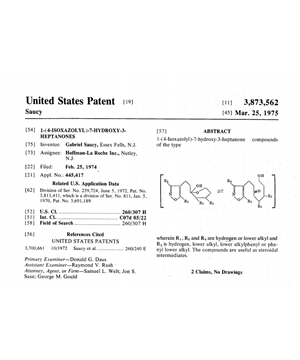
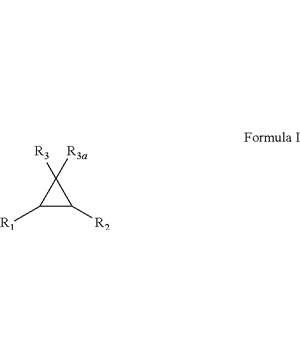

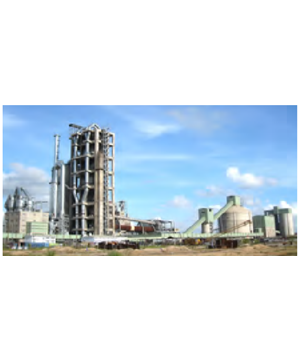
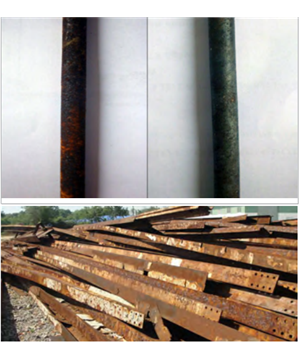
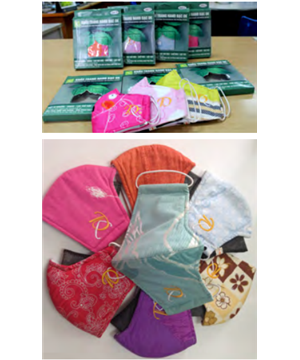
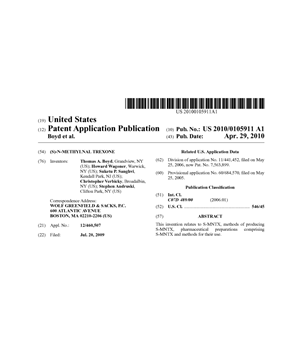
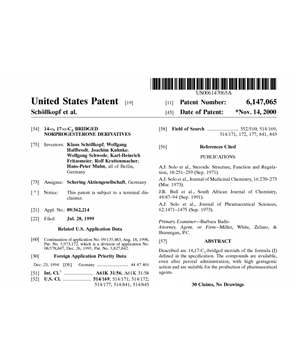
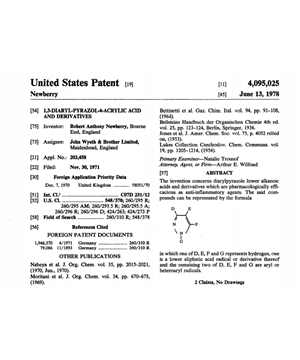
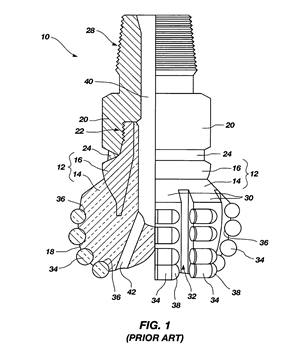
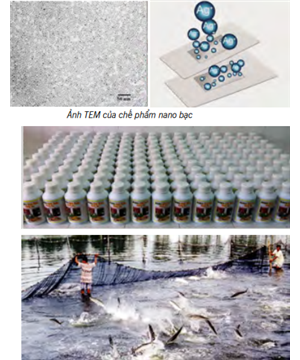






You are commenting for 1-(4-Isoxazolyl)-7-hydroxy-3-heptanones